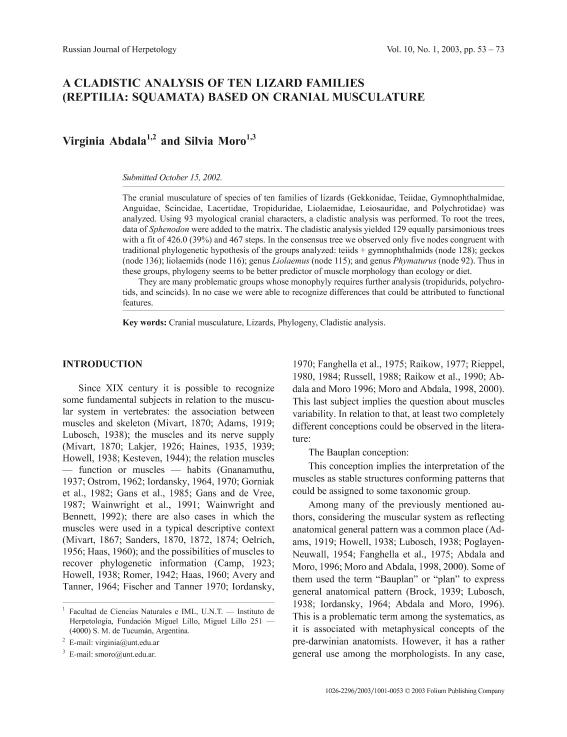Artículo
Cladistic analysis of ejemplars of ten families of Squamata based on myologycal cranial characters. Herpetology
Fecha de publicación:
12/2003
Editorial:
Folium Publishing Co.
Revista:
Russian journal of Herpetology
ISSN:
1026-2296
Idioma:
Inglés
Tipo de recurso:
Artículo publicado
Clasificación temática:
Resumen
The cranial musculature of species of ten families of lizards (Gekkonidae, Teiidae, Gymnophthalmidae, Anguidae, Scincidae, Lacertidae, Tropiduridae, Liolaemidae, Leiosauridae, and Polychrotidae) was analyzed. Using 93 myological cranial characters, a cladistic analysis was performed. To root the trees, data of Sphenodon were added to the matrix. The cladistic analysis yielded 129 equally parsimonious trees with a fit of 426.0 (39%) and 467 steps. In the consensus tree we observed only five nodes congruent with traditional phylogenetic hypothesis of the groups analyzed: teiids + gymnophthalmids (node 128); geckos (node 136); liolaemids (node 116); genus Liolaemus (node 115); and genus Phymaturus (node 92). Thus in these groups, phylogeny seems to be better predictor of muscle morphology than ecology or diet. They are many problematic groups whose monophyly requires further analysis (tropidurids, polychrotids, and scincids). In no case we were able to recognize differences that could be attributed to functional features.
Archivos asociados
Licencia
Identificadores
Colecciones
Articulos(CCT - NOA SUR)
Articulos de CTRO.CIENTIFICO TECNOL.CONICET - NOA SUR
Articulos de CTRO.CIENTIFICO TECNOL.CONICET - NOA SUR
Citación
Abdala, Virginia Sara Luz; Moro, Silvia; Cladistic analysis of ejemplars of ten families of Squamata based on myologycal cranial characters. Herpetology; Folium Publishing Co.; Russian journal of Herpetology; 10; 1; 12-2003; 53-78
Compartir




